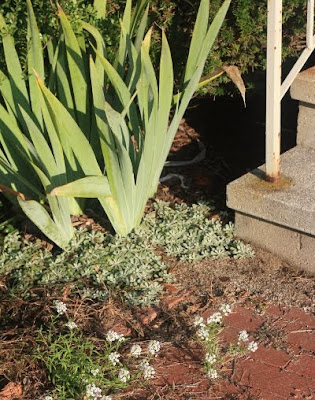But Chris and I were both longing for a rain barrel, so we did some research, and he found these: a stacking pair of plastic containers that are both more stable than a conventional barrel (and thus safer in a yard with a curious toddler), and that came in a color which matches our house. They were Chris's Christmas gift a year ago, and this past growing season, they made a surprisingly tasteful addition to our front flower bed.

Can you see the container, there in front of the house, on the right? My mother, whose aesthetic sensibilities surrounding homes will cause her to go on red alert in the presence of an over-full compost bucket waiting on the kitchen counter to be taken to the garden, walked right past these barrels and didn't see them.

You may notice that the barrels bulge a bit on the bottom right. That's our fault; we did not do a good enough job of levelling the ground where they sit. The barrels are tucked into the garage for the winter now, and in the spring we will rebuild the foundation.
Also our fault: when assembling the barrels, we neglected to follow the instructions and screwed the two containers together much too tight, ruining the connecting piece. But I got in touch with Arid Solutions Inc., the manufacturer, and I'll be damned if they weren't the most exceptionally helpful company I've ever worked with. They went above and beyond the call of duty in assisting us get the barrel fixed.

Here's what the barrels look like from the side. The right-hand hose is for watering the raspberries, but we ended up more often just filling the watering can at the spigot in the front. The short hose on the left is the overflow. When it rains and the barrel is full, the extra water pours into the birdbath, which is a far more tasteful and safe way to offer water to the wildlife than our previous orange bucket.
The water management in this spot needs more work, because during heavy rains the hose sometimes can't manage all the water, and we end up with a puddle in the garage. Again, something to fix in the spring.
I never did see any animals at the birdbath, but obviously the chipmunks like the location, because that's where all of my strawberry tops ended up. I have also seen snake-skins here, and wasps live in the sand between the rocks. Given how active the wildlife is in this little corner, I may have to overcome my tendency to kill potted plants, and include some here again next season.



















































